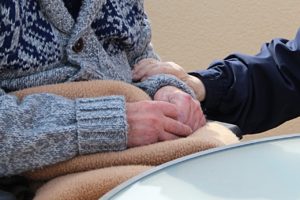Strategies to Facilitate Safe In-Person Visits

Dr. Bruce Troen, MD, professor and chief of the Division of Geriatrics and Palliative Medicine, University of Buffalo
As senior care facilities implemented physical distancing measures, it meant putting an end to in-person visits from family. The loss of those visits has a tremendous effect on residents’ mental and emotional health.
With more states starting to relax restrictions, some facilities are moving toward allowing in-person visits again. But this is a complicated decision that needs to be made deliberately and cautiously.
Understanding the Biology of COVID-19
When considering and designing in-person visits, facilities need to understand the biology of COVID-19. Dr. Bruce Troen, MD, professor and chief of the Division of Geriatrics and Palliative Medicine at the University of Buffalo, explains that infectiousness starts to wane significantly after four to seven days.
“Even though you may stay positive on the COVID RNA PCR test for some time, you’re the most infectious to others right before your symptoms develop. There’s little evidence after 14 days that you’re actually infectious.”
“That same infectiousness applies to the staff at the nursing homes,” notes Troen. “To come up with what we hope are safe recommendations, it’s not just about the residents, it’s about the staff too. Ultimately, the best way to protect nursing homes is to reduce COVID in the community.”
Troen explains, “I’ve been recommending that if a nursing home has had no infections in a resident or staff member for 14 days, then they’re positioned to consider visits of family members with residents.
“I do like the idea that they conduct this outside. Even if there’s inadvertent lack of distancing, if you’re outside with good circulation, that reduces the chance. Infection risk isn’t just matter of distance, it’s also a matter of circulation, ventilation, and time.”
Establishing Safe Outdoor Visits
Jennifer Wagner, MPH, HSE, LNHA, CEAL, and Bowling Green State University Gerontology program instructor, also agrees with holding visits outdoors as much as possible. “The weather does not always cooperate,” she adds, “so facilities should plan for indoor visits in an area that restricts visitors to one area with one-way entrances and exits.”
Wagner recommends that facilities take the following precautions when allowing visits:
- Screen all visitors and residents before visits.
- Have all visitors and residents wear proper PPE.
- Sanitize all areas between visits.
- Be flexible about allowing visits outside of the normal 9 to 5 and on weekends.
- Limit the number and frequency of visits initially.
- Consider using a signup or scheduling app, especially since there’s likely to be an initial surge of families wanting to visit.
When implementing these visitation rules, some families may need multiple sources and reminders of the rules, notes Wagner. “Phone calls, emails, texts, and general social media announcements are all needed. It is not enough to see an email and skim it or delete it.
“I would recommend that families physically receive a copy of the rules and sign them at the time of the visit. Residents should also be educated on the rules to the level they are able to be in order to help enforce the rules with their family,” she explains.
Troen also notes that having families sign an agreement can be helpful. “We do this with advanced care directives and living wills. This has real value for engaging the family in a positive way and then reinforcing that with an agreement.
“I would think and hope that just as we like to see as many community members as possible wearing masks, family members don’t want to introduce COVID to their family member, but would want others to be just as careful as they are. Signing an agreement can help to reassure family members that others who have visited the facility were just as committed to these safety measures.”
In addition to highlighting the rules, Wagner feels that a facility may need to identify the consequences that can occur if a family member breaks those rules. “For example, if a family member rushes to hug and kiss their loved one or if they deviate from the designated entry and exit or let other family members in through an exit without being screened,” says Wagner.
“Families and residents also need to be aware that if such violations occur, such as taking off your mask or kissing their family member, that resident may have to be placed in isolation or undergo additional testing to be sure that the virus has not been passed.”

Jennifer Wagner, MPH, HSE, LNHA, CEAL, and Bowling Green State University Gerontology program instructor
Deciding to Allow Visitation
The CDC has outlined considerations for nursing homes as restrictions are relaxed, but deciding when to allow visitation is a complicated choice.
Troen notes that a facility’s geographic location and the state of COVID-19 in that area will play an important role. “Here in Western New York, we’re fortunate that our positive test rate has been in the 1% range, there’s good head room for ICUs, and the infection rate is relatively low. We can probably have some comfort about how resume nursing home visits that other areas of the country cannot.”
“Honestly, I feel the jump to visitation is premature,” says Wagner. “As an ombudsman associate and an administrator, I am conflicted. Long-term care needs a phased re-opening just like amusement parks, stores, or any other business. I feel it is extremely important for residents to see their loved ones.
“However, most facilities are still not allowing communal dining, group activities, group therapy, or non-essential personnel in the building. It is my opinion that facilities should ‘practice’ with small, socially distanced groups, such as dining or activities in house before letting the public in.
“Let’s get this down, make sure there is no increase in positive cases, and then move on to family visitations. While it is important for family visits to occur, for many, the facility residents and staff are also their family. It hurts the residents just as much to not see their dining companions or friends in activities. What about the residents who won’t have visitors? They need the ability to leave their rooms and have visits, too.”
Ultimately, a facility needs to consider the risk factors in its community and within the facility, itself, when deciding when and if to start allowing in-person visits again.

Paige Cerulli is a contributing writer to i Advance Senior Care.
Related Articles
Topics: Activities , Administration , Departments , Featured Articles , Infection control , Operations , Resident Care , Risk Management










